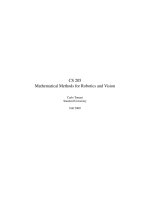CS 205 Mathematical Methods for Robotics and Vision - Chapter 1 pps
Bạn đang xem bản rút gọn của tài liệu. Xem và tải ngay bản đầy đủ của tài liệu tại đây (20.91 KB, 6 trang )
CS 205
Mathematical Methods for Robotics and Vision
Carlo Tomasi
Stanford University
Fall 2000
2
Chapter 1
Introduction
Robotics and computer vision are interdisciplinary subjects at the intersection of engineering and computer science.
By their nature, they deal with both computers and the physical world. Although the former are in the latter, the
workings of computers are best described in the black-and-white vocabulary of discrete mathematics, which is foreign
to most classical models of reality, quantum physics notwithstanding.
This class surveys some of the key tools of applied math to be used at the interface of continuous and discrete. It
is not on robotics or computer vision. These subjects evolve rapidly, but their mathematical foundations remain. Even
if you will not pursue either field, the mathematics that you learn in this class will not go wasted. To be sure, applied
mathematics is a discipline in itself and, in many universities, a separate department. Consequently, this class can
be a quick tour at best. It does not replace calculus or linear algebra, which are assumed as prerequisites, nor is it a
comprehensive survey of applied mathematics. What is covered is a compromise between the time available and what
is useful and fun to talk about. Even if in some cases you may have to wait until you take a robotics or vision class
to fully appreciate the usefulness of a particular topic, I hope that you will enjoy studying these subjects in their own
right.
1.1 Who Should Take This Class
The main goal of this class is to present a collection of mathematical tools for both understandingand solving problems
in robotics and computer vision. Several classes at Stanford cover the topics presented in this class, and do so in much
greater detail. If you want to understand the full details of any one of the topics in the syllabus below, you should take
one or more of these other classes instead. If you want to understand how these tools are implemented numerically,
you should take one of the classes in the scientific computing program, which again cover these issues in much better
detail. Finally, if you want to understandrobotics or vision, youshould take classes in these subjects, since this course
is not on robotics or vision.
On the other hand, if you do plan to study robotics, vision, or other similar subjects in the future, and you regard
yourself as a user of the mathematical techniques outlinedin the syllabus below, then you may benefit from this course.
Of the proofs, we will only see those that add understanding. Of the implementation aspects of algorithms that are
available in, say, Matlab or LApack, we will only see the parts that we need to understand when we use the code.
In brief, we will be able to cover more topics than other classes because we will be often (but not always)
unconcerned with rigorous proof or implementation issues. The emphasis will be on intuition and on practicality of
the various algorithms. For instance, why are singular values important, and how do they relate to eigenvalues? What
are the dangers of Newton-style minimization? How does a Kalman filter work, and why do PDEs lead tosparse linear
systems? In this spirit, for instance, we discuss Singular Value Decomposition and Schur decomposition both because
they never fail and because they clarify the structure of an algebraic or a differential linear problem.
3
4 CHAPTER 1. INTRODUCTION
1.2 Syllabus
Here is the ideal syllabus, but how much we cover depends on how fast we go.
1. Introduction
2. Unknown numbers
2.1 Algebraic linear systems
2.1.1 Characterization of the solutionsto a linear system
2.1.2 Gaussian elimination
2.1.3 The Singular Value Decomposition
2.1.4 The pseudoinverse
2.2 Function optimization
2.2.1 Newton and Gauss-Newton methods
2.2.2 Levenberg-Marquardt method
2.2.3 Constraints and Lagrange multipliers
3. Unknown functions of one real variable
3.1 Ordinary differential linear systems
3.1.1 Eigenvalues and eigenvectors
3.1.2 The Schur decomposition
3.1.3 Ordinary differential linear systems
3.1.4 The matrix zoo
3.1.5 Real, symmetric, positive-definite matrices
3.2 Statistical estimation
3.2.1 Linear estimation
3.2.2 Weighted least squares
3.2.3 The Kalman filter
4. Unknown functions of several variables
4.1 Tensor fields of several variables
4.1.1 Grad, div, curl
4.1.2 Line, surface, and volume integrals
4.1.3 Green’s theorem and potential fields of two variables
4.1.4 Stokes’ and divergence theorems and potential fields of three variables
4.1.5 Diffusion and flow problems
4.2 Partial differential equations and sparse linear systems
4.2.1 Finite differences
4.2.2 Direct versus iterative solution methods
4.2.3 Jacobi and Gauss-Seidel iterations
4.2.4 Successive overrelaxation
1.3. DISCUSSIONOF THE SYLLABUS 5
1.3 Discussion of the Syllabus
In robotics, vision, physics, and any other branch of science whose subject belongs to or interacts with the real world,
mathematical models are developed thatdescribe the relationshipbetween different quantities. Some of these quantities
are measured, or sensed, while others are inferred by calculation. For instance, in computer vision, equations tie the
coordinates of points in space to the coordinates of corresponding points in different images. Image points are data,
world points are unknowns to be computed.
Similarly, in robotics,a robotarm is modeled by equations that describe where each linkof the robotis as a function
of the configuration of the link’s own joints and that of the links thatsupport it. The desired positionof the end effector,
as well as the current configuration of all the joints, are the data. The unknowns are the motions to be imparted to the
joints so that the end effector reaches the desired target position.
Of course, what is data and what is unknown depends on the problem. For instance, the vision system mentioned
above could be looking at the robot arm. Then, the robot’s end effector position could be the unknowns to be solved
for by the vision system. Once vision has solved its problem, it could feed the robot’s end-effector positionas data for
the robot controller to use in its own motion planning problem.
Sensed data are invariably noisy, because sensors have inherent limitations of accuracy, precision, resolution, and
repeatability. Consequently, the systems of equations to be solved are typically overconstrained: there are more
equations than unknowns, and it is hoped that the errors that affect the coefficients of one equation are partially
cancelled by opposite errors in other equations. This is the basis of optimization problems: Rather than solving a
minimal system exactly, an optimization problem tries to solve many equations simultaneously, each of them only
approximately, but collectively as well as possible, according to some global criterion. Least squares is perhaps the
most popular such criterion, and we will devote a good deal of attention to it.
In summary, the problems encountered inrobotics and visionare optimizationproblems. A fundamental distinction
between different classes of problems reflects the complexity of the unknowns. In the simplest case, unknowns are
scalars. When there is more than one scalar, the unknown is a vector of numbers, typically either real or complex.
Accordingly, the first part of this course will be devoted to describing systems of algebraic equations, especially linear
equations, andoptimization techniques forproblems whose solutionis avector ofreals. Themain toolforunderstanding
linear algebraic systems is the Singular Value Decomposition (SVD), which is both conceptually fundamental and
practically ofextreme usefulness. When the systems are nonlinear, theycan be solved byvarioustechniquesof function
optimization, of which we will consider the basic aspects.
Since physical quantities often evolve over time, many problems arise in which the unknowns are themselves
functions of time. This is our second class of problems. Again, problems can be cast as a set of equations to be solved
exactly, and this leads to the theory of Ordinary Differential Equations (ODEs). Here, “ordinary” expresses the fact
that the unknown functions depend on just one variable (e.g., time). The main conceptual tool for addressing ODEs is
the theory of eigenvalues, and the primary computational tool is the Schur decomposition.
Alternatively, problems with time varying solutions can be stated as minimization problems. When viewed
globally, these minimization problems lead to the calculus of variations. Althoughimportant, we will skip the calculus
of variations in this class because of lack of time. When the minimization problems above are studied locally, they
become state estimation problems, and the relevant theory is that of dynamic systems and Kalman filtering.
The third category of problems concerns unknown functions of more than one variable. The images taken by a
moving camera, for instance, are functions of time and space, and so are the unknown quantities that one can compute
from the images, such as the distance of points inthe worldfrom the camera. This leads to Partial Differential equations
(PDEs), or to extensions of the calculus of variations. In this class, we will see how PDEs arise, and how they can be
solved numerically.
6 CHAPTER 1. INTRODUCTION
1.4 Books
The class willbe based on these lecture notes, and additionalnotes handed out when necessary. Other usefulreferences
include the following.
R. Courant and D. Hilbert, Methods of Mathematical Physics, Volume I and II, John Wiley and Sons, 1989.
D. A. Danielson, Vectors and Tensors in Engineering and Physics, Addison-Wesley, 1992.
J. W. Demmel, Applied Numerical Linear Algebra, SIAM, 1997.
A. Gelb et al., Applied OptimalEstimation, MIT Press, 1974.
P. E. Gill, W. Murray, and M. H. Wright, Practical Optimization, Academic Press, 1993.
G. H. Golub and C. F. Van Loan, Matrix Computations, 2nd Edition, Johns Hopkins University Press, 1989, or
3rd edition, 1997.
W. H. Press, B. P. Flannery, S. A. Teukolsky, and W. T. Vetterling, Numerical Recipes in C, 2nd Edition,
Cambridge University Press, 1992.
G. Strang, Introduction to Applied Mathematics, Wellesley- Cambridge Press, 1986.
A. E. Taylor and W. R. Mann, Advanced Calculus, 3rd Edition, John Wiley and Sons, 1983.
L. N. Trefethen and D. Bau, III, Numerical Linear Algebra, SIAM, 1997.









